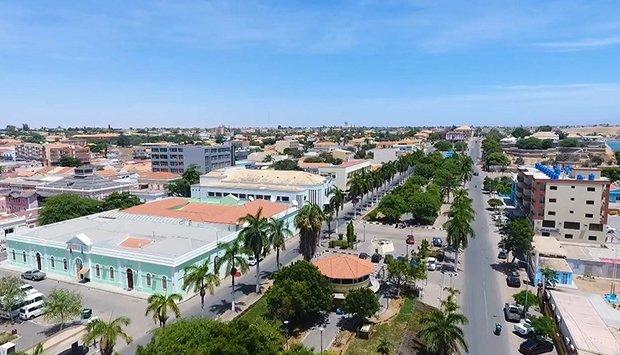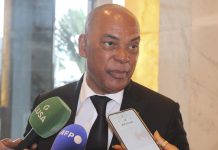Africa-Press – Angola. The city of Moçâmedes, capital of Namibe province, completes August 4th, 173 years since its foundation in 1849.
Throughout its history, the city, discovered in 1845, was already called by Angra-do-Negro, Pinheiro Furtado and, later, Moçâmedes, in honor of the general of Angola and baron of the city José de Almeida Vasconcelos de Oliveira Soveral de Carvalho . At the time, the city had a different spelling from the current one (Mossamedes).
Moçâmedes was, between 1665/1676, visited with some frequency by boats that sailed towards the South, towards the East. At this stage, they approached the bay to stock up on food and water. The first inhabitants, in search of better living conditions, opened small agricultural farms along the Bero River to grow some products for their survival.
In 1846, the year the district was founded, colonization began with the arrival, in Moçâmedes, of the first group of Portuguese immigrants, coming from Pernambuco-Brazil. Traces that point out all this historical trajectory can be found in historical sites such as the Alfândega do Namibe building, Government Palace, Santo Adrião Church, Praia Amélia chapel and the Captaincy of Porto do Namibe.
Despite some controversy, the change of name from Namibe to Moçâmedes, recently approved by the National Assembly, was consensual among members of the provincial government, the Council for Auscultation and Social Dialogue and civil society.
The municipality of Moçâmedes has a territorial extension of 8,016 square kilometers and has 282,050 inhabitants, according to the population census carried out in 2014. Moçâmedes is limited to the north by Baía Farta, province of Benguela, and by the municipality of Camucuio (Namibe). To the east it borders the municipality of Bibala, to the south by Virei and Tômbwa and to the west by the Atlantic Ocean.
Moçâmedes has three communes: Lucira, Bentiaba and Forte Santa Rita. In commemoration of the date, since the 29th of July, various cultural and sporting activities are being held, as well as a parade of artisanal fishing vessels and an exhibition of sea products. A mass of thanksgiving and a gala to honor the individual and collective personalities who contributed to the development of the municipality are also planned.
The program also reserves the “city broth” (meeting of generations) that will take place in the municipal greenhouse, with animation by local musicians and others. Tonight, fireworks are planned to be launched at three different locations.
A New Face
The painful moments in the transport of people and goods in the most populous neighborhoods of the city of Moçâmedes are behind us, with the construction of new roads accompanied by the respective public lighting systems and water supply, as guided by the Integrated Intervention Plan. in the Municipalities (PIIM).
As an example, the residents of the 5 de Abril neighborhood, which emerged in 2001 as a result of the floods, faced many difficulties in getting from their homes to commercial areas, schools, workplaces and vice versa, due to the large amounts of sand that were on the main roads. This was also experienced by the first residents of the Saydi Mingas 2 and Valódia neighborhoods, especially in the areas of Bagada, Somalia and Kamatondo.
The project to build 90 kilometers of road has given new hope to citizens who today, with only 50 percent of the work involved, already express joy at seeing the city growing.
In the second week of July, the provincial government delivered two avenues, one in the Saydi Mingas 2 neighborhood and the other in 5 de Abril, for a total of 10 kilometers that delighted the citizens.
Teacher and businesswoman Teresa Baptista, owner of the school complex “ABC”, located in the Saydi Mingas 2 neighborhood, recalls, with nostalgia, the moments she lived for transporting construction materials, as well as the robberies that students were targets in the period night. “Today the page has been turned, with the works of PIIM”, underlined Teresa Baptista.
“The feeling we have is one of joy and gratitude. It was really difficult, because access was complicated, there was loose sand, cars without traction did not go there, but I took my wish forward, I managed to build and today it is in fact a very great joy “, said.
Teresa Baptista also referred to the advantages of public lighting. “There was a lot of delinquency around, our students were often robbed for lack of lighting and now, with this project, I believe that all will decrease”, predicted the businesswoman.
Also happy with the construction of the new roads and the public lighting system is Bernardo Vimbanda, a resident of the 5 de Abril neighborhood. he considered these projects a result of the peace and vision of the Angolan Government.
Bernardo Vumbanda considered that the municipality has grown significantly, because the Moçâmedes of today is incomparable with that of yesterday. “Yesterday’s city is not today’s city, which is very beautiful. It’s just looking at the roads that suggest that it’s an advantage for us. is changing, because our government is working”, he declared.
The motorcycle taxi drivers who at times speculated on prices due to the distance and the bad condition of the roads, today are only grateful for what has been done because they no longer find excuses during their work.
“He came to help us a lot, especially in our work because before in Bairro 5 de Abril we only walked on the main road and most of the neighborhood was very sandy. So we are very grateful to our governor, Archer Mangueira, because he came to facilitate our work” , stressed Luciano Cateya, who has been in the motorcycle taxi business since 2005.
Pedro Kessongo, another motorcycle taxi driver, advised his colleagues to be cautious while driving to avoid accidents, due to the pavement that now allows high speeds. “I really liked our road, but what I’m advising us motorcyclists is just to be careful to ride well, otherwise we’re going to create many accidents. who risk driving in the wrong direction.
“The Best For Moçâmedes Is Yet To Come”
The provincial governor of Namibe, Archer Mangueira, who inaugurated the official delivery of these new sections of roads in the Saydi Mingas 2 and 5 de Abril neighborhoods, as well as the respective public lighting systems, said that the best is yet to come, as the infrastructure -structures delivered “are just the beginning of the improvement of basic social services” by the Government.
“This is an integrated project, not only covering the resealing of the roads, but also public lighting and the improvement of the water distribution system. We are still only receiving part of this project because the other is still being executed. is to pave and light up all the streets and roads in the city and get water to all the houses”, he guaranteed.
Archer Mangueira said that the social facilities delivered some time ago to residents of the Saydi Mingas 2 and 5 de Abril neighborhoods, in Moçâmedes, are part of President João Lourenço’s response to the needs of citizens.
“Today we are responding with actions. And with the delivery of these projects, part of the concerns of our population, particularly in the city of Moçâmedes, is being resolved. for them to thank the Government for what is being done because they are also beneficiaries”, he said.
Project foresees the construction of “Museu Herero”
The requalification project of Moçâmedes Bay, in Namibe, which covers the perimeter between the Port of Namibe and the Sacomar Mineral Terminal, includes the implementation of infrastructures to promote tourism, culture and leisure , recently launched by the minister of Transport, Ricardo de Abreu. Analysts said they hope that the project will completely change the city for the better.
The objective of the undertaking, included in the Integrated Development Project, is to elevate the region of Moçâmedes to the status of a free zone, creating special attractive factors for private investment, duly inserted in the National Development Policy.
In this way, the city of Moçâmedes and its people will gain a new research and leisure space, the second of its kind, dedicated to the Herero culture, complemented by spaces that allow to have valences and dynamize the city at a cultural and educational level.
This is the new “Museu Herero” (unfinished structure of the former Cine-Estúdio do Namibe), located in the vicinity of Torre do Tombo, opposite the Namibe Provincial Command of the National Police. The building is a unique architectural symbol in the country that, despite its 45 years, it presents a “futuristic aspect”.
Eugénio Fernandes, director of the Moçâmedes Bay redevelopment project, assigned to the Ministry of Transport, said that the intervention in this building is not limited to its architectural component. He said that an opportunity is being launched to create a pole of knowledge and education, which can be used daily by the population and which makes it possible to generate income for its maintenance.
In addition to the museum itself, he said, it is planned to combine the other functions of the building, such as a multipurpose auditorium, media library and restaurant, to be explored by third parties, which can function as a leisure space in day-to-day life and occasionally host various events. .
Discovered By Diogo Cão Oldest City In Southern Angola
Moçâmedes is the oldest city in the south of Angola. It was “discovered” in 1485 by the Portuguese navigator Diogo Cão.
The first name of Moçâmedes was Chitoto Chobatua (bird hole), given by the Mucubals to a village of fishermen, shepherds and hunters that existed in the bay in the 15th century.
In 1485, it was renamed Mossungo-Bitoto, and in 1645 Angra dos Negros (or Enseada dos Negros). Only in 1785, it was baptized as Baía de Moçâmedes, in honor of José de Almeida Vasconcelos, Baron of Moçâmedes.
Data indicate that the beginning of its settlement took place in 1839, with people descendants of the Bushmen, whose uses and customs still remain intact in some regions of the province.
However, its exploration began only in 1849, when the district was founded, with the arrival of the first Portuguese settlers from Pernambuco, Brazil, thus making it possible to organize the local population. The municipality, with an area of 8,916 square kilometers, has more than 335,000 inhabitants.
The Welwitschia Mirabilis Airport and the Commercial Port are the two forces that are associated with road transport and the Moçâmedes Railway for the import and export of products.
The region is rich in mineral resources such as gold, copper, manganese, chromium, tin, lignite and marble. The main agricultural productions are citrus, olive, vine and vegetables such as tomato and onion. Fishing is another means of livelihood for the inhabitants.
The Moçâmedes Railway, with 907 kilometers, reaches the city of Menongue, capital of Cuando Cubango, passing through Bibala, Lubango and Matala (in Huíla province).
The traditional Festas do Mar in the capital of Moçâmedes are the main cultural event in the city. They have lasted for 58 years and provide residents, tourists and other visitors, throughout the month of March, with an environment in which recreational, sporting and cultural activities are combined, as well as numerous business opportunities along the Namibe Marginal.
The fair always starts with a Catholic thanksgiving mass, held right on the seafront by the Diocese of Namibe. This is followed by the ritual of offerings to the sea, in which various amounts of food and drinks are thrown into the water, and the parade of fishing boats along the Miragens beach, on the Marginal.
The ribbon cutting, as well as the pyrotechnics festival (fireworks) thus mark the official opening of the party.
For More News And Analysis About Angola Follow Africa-Press






